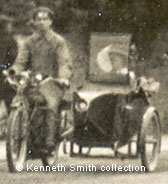|
Images Index> Matlock Dale> This page |
| Matlock Dale: Artists' Corner |
| Matlock Dale: Twentieth Century Photographs, Postcards, Engravings & Etchings |
|
|
||||||||||||
The sharp bend in the road is known as Artists' Corner, a favoured spot through the centuries for artists to come to admire the scenery and either draw or paint High Tor. This photograph probably dates from a short time before the First World War, and was possibly taken between 1910 and 1912. Just past the corner is a shop with a signboard above it; this was a grocery run by John Thomas Carding in 1911[1]. The group of buildings were known as "The Crescent" (not to be confused with Dale Crescent or Dale Road in Matlock). Charles and Emma Wildgoose lived next door to the Cardings at Findern House, The Crescent[2]. Charles was a postman and Emma let out apartments. |
 In 1911 from the left: Three storey houses: Carding, Wildgoose, Unoccupied Two storey building with flat roof: Mr Buckley (shop and home), then Keith's lock up shop |
|
|||||||
|
1, 2 and 3. "Dale Road, Matlock" No publisher details provided but no. 1417. Unposted. Postcard in the collection of and provided by and © Ken Smith. Images scanned for this website and information written, researched by and © Ann Andrews with additional input from Colin Goodwyn. Intended for personal use only. |
|||||||
References (coloured hyperlinks are to transcripts elsewhere on this web site): [1] The board over Carding's shop has been painted out years ago, of course, but it is still possible to read that name when the light catches it at the right angle. Mr. Carding didn't just run the shop. He was also employed as an asphalt maker and his wife and later his daughter who worked in the shop. Both Kelly's 1912 and Kelly's 1916 Directory shows him living at Dale Crescent. He was the son of Joseph and Blanche Carding and the family were living in Woodthorpe at the time of the 1881 census - see Strays. By the 1891 census John Thomas was living lived with an uncle in Starkholmes. [2] The 1911 census was held on 2 April 1911. [3] See who lived in "The Crescent" and the other dwellings shown on this photograph in the 1901 census. [4] See a nineteenth century photograph of the toll house [5] John Christopher Keith and Mrs. Alethea Chamberlain are listed in both Kellys 1912 Directory of Derbyshire (Matlock Bath) and Kellys 1916 Directory. JC Keith lived a few doors away in 1911, although then he was recorded as John Campbell Keith. Mrs. Chamberlain's eldest son married the great aunt of the web mistress. [6] Researched by Colin Goodwyn. [7] Rockville Cottage, later called The
Rocks, had been built "within the last two years" according
to an advertisement offering it for sale or rental. The notice
was published in "The Derby Mercury" on Wednesday,
25 March, 1840 and again a week later on 1 April, 1840. Colonel Edward Payne,
the owner, had built Tor Cottage (High
Tor Hotel) a few years earlier. So Payne built two dwellings
in the Dale. [8] Sidecars were introduced in 1905,
rapidly displacing motor cycles pulling trailers which only lasted
about three years around 1903-6. Colin Goodwyn has commented that
usually one day's exposure to dust and stones and the exhaust and
oily fumes from the bike was more than enough for a lady passenger
- if the trailer was still actually attached when the rider turned
round! He thinks the chair looks like a standard Mills-Fulford
design but maybe not that actual make. The axle of the sidecar
wheel would be in line with or up to an inch or two in front of
the motorcycle rear axle and the screen could well be behind the
riders elbow so the passenger would be behind the rider by a couple
of feet or more. It was a common arrangement. |





